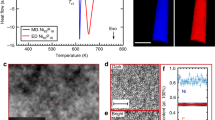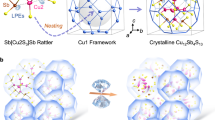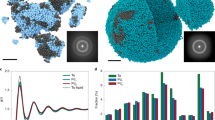Abstract
Amorphous materials have no long-range order, but there are ordered structures at short range (2–5 Å), medium range (5–20 Å) and even longer length scales1,2,3,4,5. While regular6,7 and semiregular polyhedra8,9,10 are often found as short-range ordering in amorphous materials, the nature of medium-range order has remained elusive11,12,13,14. Consequently, it is difficult to determine whether there exists any structural link at medium range or longer length scales between the amorphous material and its crystalline counterparts. Moreover, an amorphous material often crystallizes into a phase of different composition15, with very different underlying structural building blocks, further compounding the issue. Here, we capture an intermediate crystalline cubic phase in a Pd-Ni-P amorphous alloy and reveal the structure of the medium-range order, a six-membered tricapped trigonal prism cluster (6M-TTP) with a length scale of 12.5 Å. We find that the 6M-TTP can pack periodically to several tens of nanometres to form the cube phase. Our experimental observations provide evidence of a structural link between the amorphous and crystalline phases in a Pd-Ni-P alloy at the medium-range length scale and suggest that it is the connectivity of the 6M-TTP clusters that distinguishes the crystalline and amorphous phases. These findings will shed light on the structure of amorphous materials at extended length scales beyond that of short-range order.
This is a preview of subscription content, access via your institution
Access options
Access Nature and 54 other Nature Portfolio journals
Get Nature+, our best-value online-access subscription
$29.99 / 30 days
cancel any time
Subscribe to this journal
Receive 12 print issues and online access
$259.00 per year
only $21.58 per issue
Buy this article
- Purchase on Springer Link
- Instant access to full article PDF
Prices may be subject to local taxes which are calculated during checkout




Similar content being viewed by others
Data availability
The data that support the findings of this study are available from the corresponding author upon request.
Code availability
The computational code used in this study is available upon request from the corresponding author.
Change history
13 October 2021
A Correction to this paper has been published: https://doi.org/10.1038/s41563-021-01152-7
References
Elliott, S. R. Medium-range structural order in covalent amorphous solids. Nature 354, 445–452 (1991).
Price, D. L. Intermediate-range order in glasses. Curr. Opin. Solid State Mat. Sci. 1, 572–577 (1996).
Salmon, P. S., Martin, R. A., Mason, P. E. & Cuello, G. J. Topological versus chemical ordering in network glasses at intermediate and extended length scales. Nature 435, 75–78 (2005).
Mavracic, J., Mocanu, F. C., Deringer, V. L., Csanyi, G. & Elliott, S. R. Similarity between amorphous and crystalline phases: the case of TiO2. J. Phys. Chem. Lett. 9, 2985–2990 (2018).
Toh, C.-T. et al. Synthesis and properties of free-standing monolayer amorphous carbon. Nature 577, 199–203 (2020).
Lee, G. W. et al. Difference in icosahedral short-range order in early and late transition metal liquids. Phys. Rev. Lett. 93, 037802 (2004).
Shi, R. & Tanaka, H. Distinct signature of local tetrahedral ordering in the scattering function of covalent liquids and glasses. Sci. Adv. 5, eaav3194 (2019).
Gaskell, P. H. A new structural model for transition metal-metalloid glasses. Nature 276, 484–485 (1978).
Gaskell, P. H. Similarities in amorphous and crystalline transition metal-metalloid alloy structures. Nature 289, 474–476 (1981).
Pedersen, U. R., Schroder, T. B., Dyre, J. C. & Harrowell, P. Geometry of slow structural fluctuations in a supercooled binary alloy. Phys. Rev. Lett. 104, 105701 (2010).
Madden, P. Materials science - a hard look at glass. Nature 435, 35–36 (2005).
Ma, D., Stoica, A. D. & Wang, X. L. Power-law scaling and fractal nature of medium-range order in metallic glasses. Nat. Mater. 8, 30–34 (2008).
Wu, Z. W., Li, M. Z., Wang, W. H. & Liu, K. X. Hidden topological order and its correlation with glass-forming ability in metallic glasses. Nat. Commun. 6, 6035 (2015).
Chen, D. Z. et al. Fractal atomic-level percolation in metallic glasses. Science 349, 1306–1310 (2015).
Schroers, J. Processing of bulk metallic glass. Adv. Mater. 22, 1566–1597 (2010).
Martin, J. D., Goettler, S. J., Fosse, N. & Iton, L. Designing intermediate-range order in amorphous materials. Nature 419, 381–384 (2002).
Benmore, C. J. et al. Intermediate range chemical ordering in amorphous and liquid water, Si, and Ge. Phys. Rev. B 72, 132201 (2005).
Luo, Y. & Samwer, K. Local atomic order of a metallic glass made visible by scanning tunneling microscopy. J. Phys. Condens. Matter 30, 245702 (2018).
Hirata, A. et al. Direct observation of local atomic order in a metallic glass. Nat. Mater. 10, 28–33 (2010).
Hirata, A., Hirotsu, Y., Ohkubo, T., Hanada, T. & Bengus, V. Z. Compositional dependence of local atomic structures in amorphous Fe100−xBx (x = 14, 17, 20) alloys studied by electron diffraction and high-resolution electron microscopy. Phys. Rev. B 74, 214206 (2006).
Treacy, M. M. & Borisenko, K. B. The local structure of amorphous silicon. Science 335, 950–953 (2012).
Crupi, C., Carini, G., González, M. & D’Angelo, G. Origin of the first sharp diffraction peak in glasses. Phys. Rev. B 92, 134206 (2015).
Yao, K. F. & Kui, H. W. Evidence of a two-dimensional nucleation and growth mechanism for metastable nanocrystals embedded in Pd40.5Ni40.5P19 glass. Appl. Phys. Lett. 77, 2313–2315 (2000).
Kahl, A. et al. Dynamical and quasistatic structural relaxation paths in Pd40Ni40P20 glass. Appl. Phys. Lett. 95, 201903 (2009).
Lan, S., Wu, Z. D., Lau, M. T. & Kui, H. W. Crystallization in homogeneous and phase-separated Pd41.25Ni41.25P17.5 bulk metallic glasses. J. Non-Cryst. Solids 373-374, 5–12 (2013).
Lan, S. et al. Hidden amorphous phase and reentrant supercooled liquid in Pd-Ni-P metallic glasses. Nat. Commun. 8, 14679 (2017).
Tulk, C. A., Molaison, J. J., Makhluf, A. R., Manning, C. E. & Klug, D. D. Absence of amorphous forms when ice is compressed at low temperature. Nature 569, 542–545 (2019).
Iakoubovskii, K., Mitsuishi, K., Nakayama, Y. & Furuya, K. Thickness measurements with electron energy loss spectroscopy. Microsc. Res. Tech. 71, 626–631 (2008).
Chiang, T. F. et al. Auto-correlation function analysis of crystallization in amorphous SiGe thin films. Appl. Surf. Sci. 212–213, 339–343 (2003).
Tang, X. P., Geyer, U., Busch, R., Johnson, W. L. & Wu, Y. Diffusion mechanisms in metallic supercooled liquids and glasses. Nature 402, 160–162 (1999).
Guan, P. F., Fujita, T., Hirata, A., Liu, Y. H. & Chen, M. W. Structural origins of the excellent glass forming ability of Pd40Ni40P20. Phys. Rev. Lett. 108, 175501 (2012).
Hirata, A., Hirotsu, Y., Ohkubo, Y., Tanaka, N. & Nieh, T. G. Local atomic structure of Pd–Ni–P bulk metallic glass examined by high-resolution electron microscopy and electron diffraction. Intermetallics 14, 903–907 (2006).
Cowley, J.M. Diffraction Physics Ch. 11 (North-Holland, 1981).
Lee, G. W. et al. Local structure of equilibrium and supercooled Ti-Zr-Ni liquids. Phys. Rev. B 77, 184102 (2008).
Benmore, C., Gallington, L. C. & Soignard, E. Intermediate range order in supercooled water. Mol. Phys. 117, 2470–2476 (2019).
Blum, M. C., Cavar, E., Pivetta, M., Patthey, F. & Schneider, W. D. Conservation of chirality in a hierarchical supramolecular self-assembled structure with pentagonal symmetry. Angew. Chem. Int. Ed. Engl. 44, 5334–5337 (2005).
Westbrook, J. H. & Fleischer, R. L. Intermetallic Compounds – Principles and Practice (Wiley, 2002).
Sheng, H. W., Luo, W. K., Alamgir, F. M., Bai, J. M. & Ma, E. Atomic packing and short-to-medium-range order in metallic glasses. Nature 439, 419–425 (2006).
Miracle, D. B. A structural model for metallic glasses. Nat. Mater. 3, 697–702 (2004).
Kresse, G. & Hafner, J. Ab initio molecular dynamics for liquid metals. Phys. Rev. B 47, 558–561 (1993).
Acknowledgements
We wish to thank H. W. Kui for helpful discussions, Z. G. Ding for first-principles calculations and E. P. Gilbert for SANS measurements at QUOKKA in ANSTO, Australia. We also acknowledge the help of J. Zhang for ex-situ high-resolution synchrotron X-ray diffraction measurements in Taiwan Photon Source, J. Wu for preparing the ultrathin TEM samples by cryogenic focus ion beam in SUSTech Cryo-EM Facility Center and Z. Zhou of Tencent for developing the computer program for image matching. This work was supported by the National Natural Science Foundation of China (grant nos. 51871120, 51571170, 51520105001), the Natural Science Foundation of Jiangsu Province (grant no. BK20200019) and the Fundamental Research Funds for the Central Universities (grant nos. 30919011107, 30919011404). Z.W. and X.-L.W. acknowledge support by Guangdong-Hong Kong-Macao Joint Laboratory for Neutron Scattering Science and Technology (grant no. 2019B121205003). X.-L.W. was supported in part by grants from the Croucher Foundation (project no. CityU 9500034) and the Research Grants Council of Hong Kong SAR (grant no. JLFS/P-102/18). This research used the resources of the Advanced Photon Source, a US Department of Energy (DOE) Office of Science User Facility operated for the DOE Office of Science by Argonne National Laboratory under contract no. DE-AC02-06CH11357. We acknowledge the support of the Australian Centre for Neutron Scattering, Australian Nuclear Science and Technology Organization, in providing the neutron scattering research facilities used in this work.
Author information
Authors and Affiliations
Contributions
S. Lan initiated the project and conceived the idea with L.Z., Z.W., Y.R. and X.-L.W. S. Lan, Y.R. and X.-L.W. supervised the project. S. Lan, Z.W., S. Liu and P.W. prepared the samples and TEM specimens. S. Lan and Y.R. performed in-situ synchrotron X-ray diffraction experiments at 11-ID-C of APS, ANL. S. Lan, L.Z., Z.W., Q.L., Y.R. and X.-L.W. analysed the PDF results. S. Lan, Z.W., J.L., P.W., Q.Z. and L.G. performed the TEM/STEM work. L.G. and Q.Z. performed HAADF–STEM, EDS mapping and did the related analysis, together with L.Z., Z.W., S. Liu and S. Lan. S. Lan and H.K. did the STM study. S. Lan and G.S. did the APT work. S. Lan and L.Z. constructed the structure model with the help of R.S. and Y.R. S. Lan and L.Z. drafted the manuscript together with Z.W., L.G., Y.W., C.-T.L., Y.R. and X.-L.W. All authors analysed and reviewed the results and provided input to this paper.
Corresponding authors
Ethics declarations
Competing interests
The authors declare no competing interests.
Additional information
Peer review information Nature Materials thanks the anonymous reviewers for their contribution to the peer review of this work.
Publisher’s note Springer Nature remains neutral with regard to jurisdictional claims in published maps and institutional affiliations.
Extended data
Extended Data Fig. 1 In-situ small-angle neutron scattering (SANS) study indicating the nano-precipitates prior to the final crystallization.
SANS profiles of the Pd41.25Ni41.25P17.5 MG at room temperature (RT) and 655.5 K, a temperature ~10 K lower than its final crystallization temperature. The inset is the pair distance distribution function (PDDF) of the Pd41.25Ni41.25P17.5 MG at 655.5 K.
Extended Data Fig. 2 More structural information about the cube phase obtained by STEM.
a-b, HAADF and Bright-field image for the Pd-Ni-P MG after precipitation. c-f, Fast-Fourier-Transform (FFT) patterns for the cube phase along [100], [110], [111] and [211] directions, respectively.
Extended Data Fig. 3 More evidence supporting the existence of the medium-range building block in the amorphous phase from the HAADF-STEM observation, and the Cs-corrected high-resolution transmission electron microscopy (HRTEM) images to observe the atomic structure of the cube phase.
a, Cs-corrected HAADF-STEM images for the cube phase taken with [211] zone axis. The upper right panel is the ACF processed two-dimensional images calculated from the red square regions in the cube phase. The bottom right panel is the ACF processed images from the yellow square regions in the amorphous matrix. b-e, Cs-corrected HRTEM images after the average background subtraction filtering (ABSF) for the cube phase taken with [100], [110], [111] and [211] zone axis, respectively.
Extended Data Fig. 4 Observing the cube phase and the amorphous Pd-Ni-P by scanning tunneling microscopy (STM).
a, STM image for Pd-Ni-P MG with the cube phase along with its higher magnification image in b. c, STM image for Pd-Ni-P alloy annealed at 583 K along with its higher magnification image in d. The 583-K sample retains fully amorphous structure.
Extended Data Fig. 5 Determining the composition distribution of the cube phase by EDS-mapping.
a and b, HAADF image of the cube phase taken with the [100] and [110] zone axis. c-e, Corresponding EDS maps for Pd, Ni, and P taken with the [110] zone axis, respectively. f, Line profiles of an atomic fraction of individual elements (Pd, Ni, and P) along the dotted yellow line in the EDS maps in Fig. 2e–g. g, Line profiles of an atomic fraction of individual elements (Pd, Ni, and P) along the dotted yellow line in the EDS maps in Extended Data Fig. 5c–e.
Extended Data Fig. 6 Determining the composition of the cube phase by atom probe tomography (APT).
a, Three-dimensional reconstructed P atom maps of the Pd-Ni-P MG with precipitates defined by iso-concentration surfaces at 5.1 nm−3 P (in green) using atom probe tomography. b, Two-dimensional elemental maps for the selected P-poor region (precipitate). c, One-dimensional concentration profiles through the center of the selected P-poor region (precipitate).
Extended Data Fig. 7 Schematic illustration of the packing scheme for the cube phase.
Two-dimensional view of the packing scheme along [100], [110] and [111] directions, respectively. Red balls are Pd and Ni atoms, whereas the blue balls represent P atoms. The orange-coloured polyhedron represents the Pd-enriched small cluster, and the blue-coloured polyhedron represents the Ni-enriched small cluster.
Extended Data Fig. 8 Evidence supporting the existence of the 6M-TTP clusters in the amorphous structure of Pd-Ni-P alloy by cluster-image comparisons and image simulation of an amorphous structure.
a, A comparison between the medium-range order in the 2D-DF HAADF-STEM image of the 583-K annealed Pd-Ni-P sample and the proposed 6M-TTP cluster. The yellow circles mark the position of the potential 6M-TTP clusters. The image is surrounded by seven enlarged 2D-DF HAADF-STEM images, in which the modelled 6M-TTP cluster and the corresponding STEM simulation results are superimposed. Three major symmetry directions, that is, [100], [110] and [111], can be clearly seen, which are similar to those of 6M-TTP projections. The comparisons are shown in sub-panels (I-II), (III-IV), and (V-VII), respectively. The bottom right panel is the FFT pattern demonstrating amorphous nature. b, A comparison between the medium-range order in the 2D-DF HAADF-STEM image of as-cast Pd-Ni-P sample and the proposed 6M-TTP cluster. The yellow circles mark the position of the 6M-TTP clusters. I-III, Enlarged 2D-DF HAADF-STEM images, in which the modelled 6M-TTP cluster and the corresponding STEM simulation results with [100], [110], and [111] orientations are superimposed, respectively. The bottom right panel is the FFT pattern demonstrating amorphous nature. c, Structure model of the random packed atomic structure with embedded 6M-TTP clusters and d, HREM simulation by multislice technology using xHREM software. Gray balls represent the metal atoms (Pd/Ni), and purple balls are the metalloid atoms (P). The circled regions are the embedded 6M-TTP clusters with [100], [110], and [111] orientations, respectively. e, The enlarged image of Extended Data Fig. 8a.
Extended Data Fig. 9 Illustrating the characteristic of the cube phase by selected area electron diffraction (SAED).
SAED patterns for: a as-cast, b cube phase precipitated and c leached Pd-Ni-P samples, respectively. d, Plots of diffraction intensity (I(Q)) versus scattering vector (Q) obtained by integrating the SAED pattern images. The arrows mark the reproduced shoulders in the Pd-Ni-P sample with the cube phase.
Extended Data Fig. 10 Schematic illustration of the chirality for the 6M-TTP.
Left panel: a polyhedral model for the 6M-TTP. The red and blue balls represent metal (Pd and Ni) and P atoms, respectively. Right panel: the corresponding configuration obtained by a mirror-symmetry operation.
Supplementary information
Supplementary Information
Supplementary Notes, Supplementary Figs. 1–12 and associated legends.
Rights and permissions
About this article
Cite this article
Lan, S., Zhu, L., Wu, Z. et al. A medium-range structure motif linking amorphous and crystalline states. Nat. Mater. 20, 1347–1352 (2021). https://doi.org/10.1038/s41563-021-01011-5
Received:
Accepted:
Published:
Issue Date:
DOI: https://doi.org/10.1038/s41563-021-01011-5
This article is cited by
-
Intrinsic dichroism in amorphous and crystalline solids with helical light
Nature Communications (2024)
-
Elemental partitioning-mediated crystalline-to-amorphous phase transformation under quasi-static deformation
Nature Communications (2024)
-
Toughening oxide glasses through paracrystallization
Nature Materials (2023)
-
Enhancement of short/medium-range order and thermal conductivity in ultrahard sp3 amorphous carbon by C70 precursor
Nature Communications (2023)
-
Non-affine atomic rearrangement of glasses through stress-induced structural anisotropy
Nature Physics (2023)



